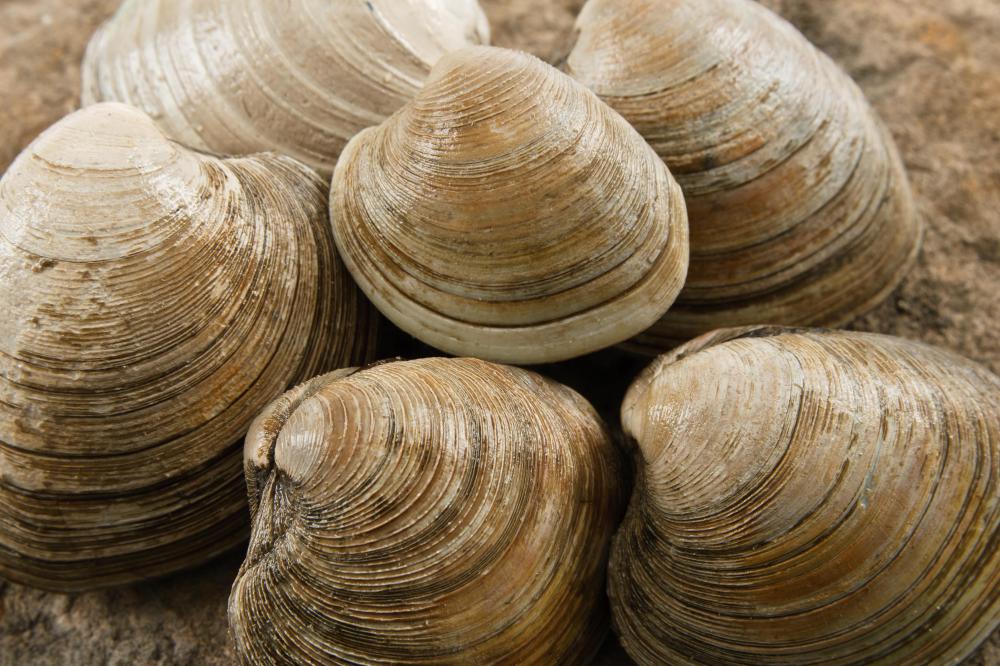At WiseGEEK, we're committed to delivering accurate, trustworthy information. Our expert-authored content is rigorously fact-checked and sourced from credible authorities. Discover how we uphold the highest standards in providing you with reliable knowledge.
What Is Clam Sauce?
Clam sauce is a popular topping for pasta, especially linguine. There’s no single way to make it, which is one of the wonderful things about it — like so many Italian dishes, it’s very flexible and can accommodate many different tastes. When served over pasta, it’s also one of the most economical meals one can prepare either for oneself or for the entire family.
There are generally two different types of clam sauce: red and white. The main difference between them is that the red has tomatoes. Red clam sauce can be made with fresh tomatoes, canned tomatoes, canned tomato paste or sauce.

When fresh clams are used, they’re generally steamed, the shells discarded, and the meat used with the naturally-occurring clam juice. Using fresh clams adds time, cost and effort to the sauce’s preparation, though, and it’s perfectly acceptable to use canned or frozen clams. Some markets sell cans of cooked baby clams, and most carry canned clams which have been either chopped or minced. All three varieties are fine, and some cooks combine two or three varieties when making large amounts. If frozen clams are used, it’s advisable to also purchase a bottle of clam juice to add to the sauce.

Garlic and onions are standard ingredients of most clam sauces, and olive oil is the most popular choice of oils. Other ingredients are sometimes called for as well, the most popular of which are mushrooms and anchovies, either fillets or paste. If anchovy fillets are used, they’re cooked to dissolve in the oil; they’re never intended to be served whole. These ingredients are generally prepared before the clams are added; in fact, the clams are usually added last, immediately before serving.

Traditional Italian seasonings such as oregano, basil, marjoram and parsley are usually used in making clam sauce. A touch of tarragon will add a seaside flavor, and many recipes also call for small quantities of lemon juice. Cooks who want a spicier sauce will add crushed red pepper flakes or hot sauce in small amounts. If the sauce becomes too watery, it’s acceptable to use flour in small amounts to thicken it.

Clam sauce can usually be prepared very quickly; in fact, it generally takes longer to prepare the pasta than it does to cook the sauce. Some sauce recipes, however, are more involved, calling for wine, additional clam juice or chicken stock as liquids, which must be cooked down to blend the flavors properly. Red sauce can also take significantly longer if fresh or canned whole tomatoes are used, as they have to cook down. If tomato paste or sauce are used, though, they add only a few moments to the preparation time. Clams require very little cooking time, and should be added last to the sauce, just a few moments before serving.
Linguine is the overwhelming choice of pastas when preparing clam sauce. It should be prepared al dente, that is, just a touch firm and chewy. Cooks can be very flexible in how they prepare the linguine once it’s been cooked and drained, although most prefer to toss it with butter or olive oil, with just a touch of salt and pepper, before serving.
Some cooks prefer to mix the sauce into the linguine before serving it. Others serve the two separately and let their guests serve themselves. Linguine with clam sauce should be served with grated or shredded Parmesan or Asiago cheese, a fresh garden salad and garlic bread.
AS FEATURED ON:
AS FEATURED ON:














Discussion Comments
Though it usually depends of what kind of sauce you're making, generally speaking, consistency is very important. This is especially the case with clam sauce. Depending on how you intend to use the clam sauce, it can be better to make it more thick, or in some cases, more runny. Just remember, the sauce can make or break a pasta.
After all, even though many people do enjoy eating pasta, it's really the sauce that counts, since without it, you're eating pasta noodles plain and bland. The sauce is the base of your dish, and it ties everything together perfectly. Overall, always remember to follow instructions to a T, and do some specific research on what kinds of sauces (thick or light) you should be using for your dish.
Even though it's true that clam sauces are quite tasty, on the other hand, I wonder if some chefs would feel insulted if you were to use it at a restaurant. At home, if you were to use it, that would be all right. However, in terms of dining out, it's a completely different story. In fact, let's look at it this way, although many waiters in cooks at restaurants don't care if you use dipping sauces for your food, others do.
For example, let's say that you were to go to a fancy restaurant, such as one that serves seafood. The cooks might be a bit insulted if you were to use certain dipping sauces. They want you to taste the dish the way it was created, and not based on how it tastes with certain dipping sauces. As Americans, we are used to eating many things dipped in sauce, but when going to exceptional restaurants, this is definitely something to take into consideration.
Post your comments